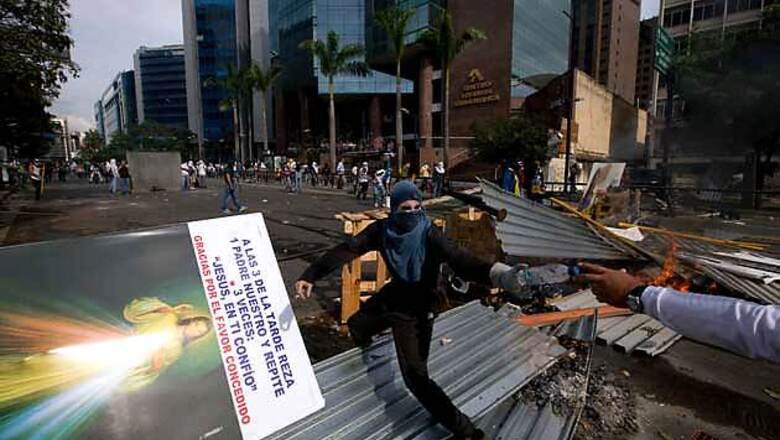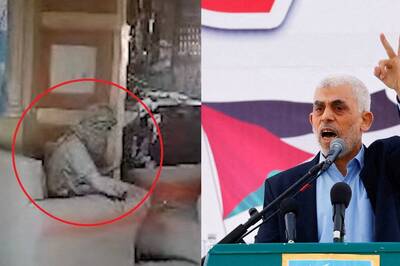
views
Like a beaver dam of urban detritus, the piles of tires, old mattresses and heavy steel grates in Venezuela's streets have sparked some of the most violent episodes of this tumultuous season of protest and repression.
The barricades in Caracas' middle-class neighborhoods and swaths of opposition-governed cities aim to disrupt, frustrate and ultimately trigger a popular revolt. But like the broader, mostly peaceful anti-government movement it grew out of, the tactic has so far failed to sow wider unrest.
Indeed many in the opposition regard the barricades as a gift to embattled President Nicolas Maduro, who hasn't missed an opportunity to highlight the hours-long traffic jams caused by the obstructions that frustrate Venezuelans on both ends of the political spectrum.
Calling them "guarimbas," which Venezuelans associate with home base in a child's game of hide-and-seek, Maduro has repeatedly cited the barricades as evidence that his opponents aren't fit to govern.
He also portrays them as a small minority that wants to undo Venezuela's socialist policies aimed at helping the poor.
"The anti-government protests are being carried out by people in the wealthier segments of society who seek to reverse the gains of the democratic process that have benefited the vast majority of the people," Maduro wrote in an op-ed piece published in Wednesday's New York Times.
Although contested details obscure a conclusive count, the government says at least 11 people, among them student protesters and pro-government motorcycle riders, have been killed clearing or defending the barricades, or simply crashing into them. Some say the real toll is double that amount.
As quickly as they are erected, pro-government militias attempt to tear them down, sparking a violent turf war for control of the streets.
While marches by Venezuelans fed up with a tottering economy, rampant crime and crackdown on dissent still fill streets by day in many parts, the barricades are often erected in mostly middle-class, opposition neighborhoods at night.
On a recent evening, a half dozen figures dragged heavy sacks of debris, twisted metal and watermelon-size chunks of concrete into the middle of a Caracas street. In minutes they'd erected a sizeable barricade, topped with a wooden sign that read "Libertad," Spanish for freedom. Just as quickly, they melted back into the shadows.
But one activist, nearly double the age of the others, lingered on the corner. He was the king of the guarimba in this part of town.
Gustavo Perez, a 41-year-old chef with close-cropped salt and pepper hair, didn't flaunt his royal bearing and it's unlikely anyone outside his two-block kingdom was aware of his position. Still, that's how a waiter from the cafe across the street introduced Perez with more than a hint of disdain.
"You create chaos. All day you create discomfort, a delay in everything," said Perez as he explained his strategy of insurrection. "The people don't arrive early to their jobs, sometimes they can't leave. The little food there is to distribute doesn't arrive to the supermarkets. Then it creates a domino effect. The idea is to collapse the city so that people go out into the streets."
But the plan never reached critical mass and ultimately Perez's neighbors felt the pain more than the government did. Not surprisingly many of the barricades in Caracas, including Perez's, have disappeared as opponents adopt new creative forms of protest, such as colorful sit-ins outside the offices of the United Nations.
Outside Caracas, in restive cities such as San Cristobal and Valencia, the barricades remain strong and aren't limited to middle-class neighborhoods.
True to their roots as a symbol of radical activism since the days of the French Revolution, some are fiercely defended with rocks and Molotov cocktails and passage denied to nearly anyone as locals tried to defend areas from pro-government vigilantes. The government says that in their most devious form, they included thin wires stretched taught across the street, oil slicks and segments of garden hose spiky with nails.
Some of the loyalist groups, known as colectivos, have gone into the street to clear the barricades, at times by force, said Lisandro Perez, a founder and political director for the Tupamaros in the Chavista stronghold of 23 de enero.
"That is what we've done: clean the streets, take down the barricades," said Perez, also known as Comandante Mao. "In some areas of Caracas and the country, most of all in Tachira, yes, we have had to clash. That is to say, to try to eliminate the guarimba."
Carlos Balladares, a history professor at the Central University of Venezuela, said the barricades first appeared in 2004, when residents of middle and upper class Caracas neighborhoods protested after signatures gathered to force a recall referendum on then President Hugo Chavez were rejected. But they didn't spread beyond Caracas and then as now haven't met their goal of producing a political awakening among even Venezuela's better off.
"I believe it could have the opposite effect," he said. "People are going to be more annoyed by you and with the protest."
That was certainly Perez's experience with his barricade.
Within a 50-yard radius of his barricade are a cafe, a women's clothing shop, a store selling barbecue grills and a gourmet deli with tiny jars of caviar. There could not be many places more intensely opposed to Maduro's socialist revolution.
"There are a lot of ways to protest other than this," said Gilda Da Silva, owner of the clothing shop. "Because this, what it does is harm all of us." Da Silva said her sales were way off since the barricade went up. "I want to work. I have to work. I can't stop."
Ramon Muchacho, mayor of the wealthy Caracas district of Chacao, said that while he supports the protests he has begun pleading with his constituents not to block the streets. His job may depend on them heeding his call: The Supreme Court has used the failure to keep streets open as justification to sentence two opposition mayors to prison.
"We've had confrontations between neighbors who are all opposed to the government, but one blocks the street and the other wants to open it," he said in an interview.
Ramon Suarez, a 55-year-old taxi driver from the outskirts of Caracas, said he has suffered gridlock traffic. He said the obstacles only reinforce his view of the opposition.
"They are the upper-middle class who don't like to do anything, including work," he said. "They like everything easy."



















Comments
0 comment